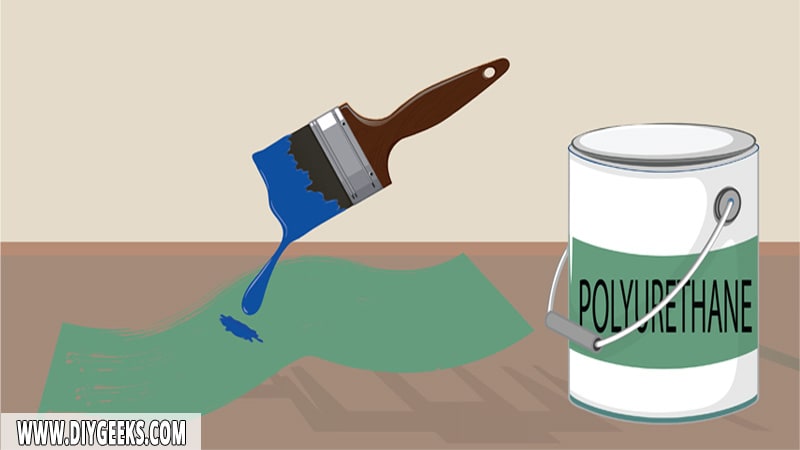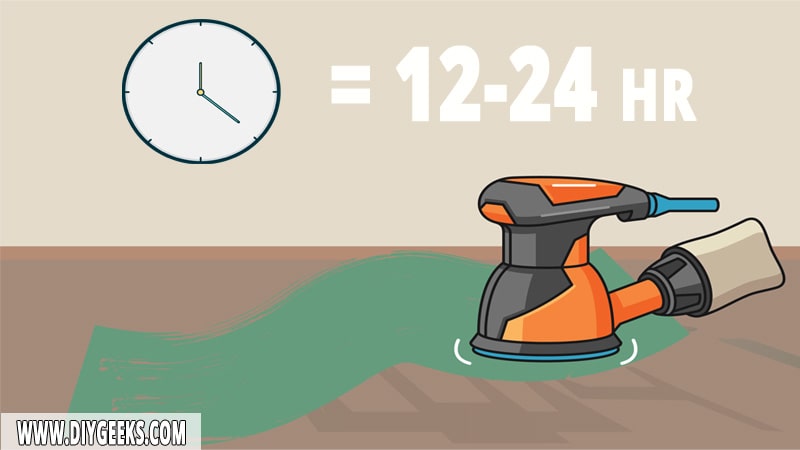You need to sand between polyurethane coats to remove imperfections, bumps, dust build-up, brush marks, or dirt from the previous coating.
If you don’t sand between polyurethane coating, the subsequent coatings won’t adhere (bond) properly as the imperfections, bumps, and dust nibs will prevent it from adhering and settling over the coating properly.
You must sand before applying polyurethane and between coats of it. But, you shouldn’t sand the final coating as it will remove its glossy finish and expose the surface to different elements.
Why Should You Sand Between Polyurethane Coats?

You must sand between polyurethane coats for the following reasons.
- Removes dust and debris.
- Removes brush marks.
- Removes imperfections.
- Improves adhesion between coats.
- Enhances smoothness.
- Ensures long-term durability.
- Improves finish quality.
If a surface has dust, debris, brush marks, or imperfections, it will prevent subsequent coats from adhering properly and result in a rough and uneven finish.
To improve the adhesion between coats and get a smooth finish, the surface and the previous coats must be smooth too.
Brush marks, imperfections, or dust nibs will be visible because polyurethane has a colorless finish and doesn’t cover them. If you don’t sand between coats, the next coat will be applied over dust and brush marks, resulting in an uneven finish.
Polyurethane has a glossy finish that repels moisture (or liquid). You must sand off the glossy layer between layers or the next coating won’t adhere.
What Happens If You Don’t Sand Between Coats of Polyurethane?
If you don’t sand between coats of polyurethane, the finish will be uneven, sticky, and blurry, and it will peel off. The coatings will have a weak adhesion, visible brush marks, lower durability, and will take longer to dry.
Dust or dirt trapped on the existing coat will prevent the next coating to adhere properly. Since the coating won’t adhere properly, it will remain wet longer, turn sticky, and peel off.
Brush marks will be visible too as polyurethane is colorless and doesn’t cover them or any imperfections. You must sand between coats to remove the imperfections, brush marks, or bumps before applying the next coating.
You must remove the glossy layer of polyurethane as it will prevent the new coating from adhering properly.
Do You Need to Sand Before Applying Polyurethane?
You need to sand before applying polyurethane to remove imperfections, blemishes, pencil marks, glue, dust, dirt, and bumps and even out the surface. All of these elements will be visible once the polyurethane coating dries if you don’t sand the surface.
These imperfections will also impact the finish quality, smoothness, and drying time of the sealer.
To sand bare wood surfaces before poly, start with medium-grit sandpaper (120/150-grit), and finish with fine-grit sandpaper (220-grit).
You must sand wood surfaces as they have pencil marks, glue residue, and dents left by the carpenter, which can prevent good adhesion and result in an uneven finish.
You must sand if the surface is already finished (sealer) with another sealer. Sanding will remove the existing finish, leaving behind a bare and smooth surface. If you don’t sand, polyurethane won’t adhere well to sealed surfaces.
Sand with coarse-grit sandpaper (40-grit) if the surface is sealed with a strong and durable sealer, such as exterior varnish. Sand with medium or fine-grit sandpaper if the surface is finished with paint (and you want to remove it).
Do You Need to Sand Between Polyurethane Coats?
You need to sand between polyurethane coats to remove imperfections, and bumps, and abrade the previous coating to improve the adhesion. Sanding must only abrade the previous coating, not remove it.
To sand between coats of polyurethane, use fine-grit sandpaper (120/220-grit) as the sealer isn’t thick. Using medium or coarse-grit sandpaper (100 or 40-grit) may remove the entire finish.
Simply swipe the fine-grit sandpaper (120/220-grit) over the coating until the imperfections are removed. If the coating has minimal imperfections, use extra-fine grit sandpaper (440-grit) and don’t sand as much.
While sanding, it’s important to follow a proper technique to get better results. Apply light to moderate pressure, and avoid pressing the sandpaper too much as that can remove some parts of the finish. Always sand in the direction of the grain.
After sanding each coat, remove dust particles or sanding residue using a clean lint-free cloth. This ensures that the coating is clean and improves the adhesion when the next coating is applied.
[su_youtube url=”https://www.youtube.com/watch?v=YD_bdOoRdK4″]
Do You Need to Sand The Final Coating?
You don’t need to sand the final coating of polyurethane as it removes its glossy, protective, UV-resistant, and moisture-resistant layer, exposing the surface underneath to weather elements.
The purpose of polyurethane is to protect the surface (or finish) underneath by producing a flexible, glossy, UV-resistant, and moisture-resistant coating. This coating prevents water (and other liquids) from reaching the surface (or finish) underneath.
You will remove this protective barrier and expose the surface to weather elements if you sand the final coating. Basically, it defeats the purpose of the sealer.
However, if the final coating has an imperfection, sand it with extra fine-grit sandpaper (440-grit). The extra fine-grit sandpaper will remove the imperfections, but won’t remove the glossy protective barrier of the sealer.
Related Read: Should You Sand Coats of Stain?
How Long To Wait Before Sanding?

You must wait until the polyurethane coating fully dries (24-48 hours) before sanding it. On average, it’s recommended to wait 24 hours before sanding a polyurethane coating.
The exact drying time depends on factors such as the sealer type, room temperature, humidity levels, thickness of the coat, and surface type.
For example, water-based polyurethane typically cures within 24 hours due to its water-based solvent. While oil-based polyurethane may take up to 48 hours to fully dry (cure) due to the slower evaporation rate of oil.
For the sealer to dry, its solvent (water or oil) must evaporate from the existing coating. Once the solvent evaporates, the coating begins to oxidize and harden.
Once the coating has hardened and fully dries, you can sand it. Since polyurethane is a thin finish, it’s crucial to allow its coating to dry fully to avoid damaging it.
Are There Polyurethane Types That You Don’t Need To Sand?
Yes, you don’t need to sand fast-drying polyurethane as it dries fast and doesn’t stay sticky (or wet) for too long.
The longer a coat stays sticky (or wet), the more dust or dirt it will attract. So, if the coating dries fast and doesn’t stay wet for too long, the dust or dirt that it will attract will be minimal.
Instead of sanding fast-drying polyurethane, use a clean cloth to wipe it before applying the next coating.
According to Minwax, a leading brand for producing polyurethanes and wood stains, fast-drying polyurethane takes only 4-6 hours to dry between coats.
How Many Coats of Polyurethane Do You Need?
You need 2-5 coats of polyurethane on a surface for proper protection. If the surface doesn’t need much protection, apply 2-3 coats. If the surface is placed outdoors and needs more protection, apply 5 coats.
The minimum number of coats of polyurethane is 2, while the maximum is 5 coats. If you apply less than 2 coats or more than 5 coats, the finish won’t be smooth, it won’t protect the surface properly, and it can turn sticky (or remain wet).
Can You Re-coat Polyurethane Without Sanding?
You can’t re-coat polyurethane without sanding if you want a smooth and durable finish. However, you can use steel wool instead of sandpaper.
Steel wool, an abrasive material used for burnishing, can remove imperfections from a coating before you apply the next one. It’s recommended to use 0000-grit steel wool between coats of polyurethane.
You can apply one coat of polyurethane if you don’t want to sand a surface. However, one coat isn’t enough to protect a surface.


